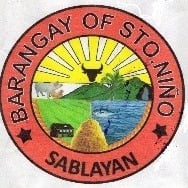Barangays > Santo Niño

|
Brief History |
Only a few individuals owned the wide plains in this place during the American regime. They were Vicente Gatchalian, Paulino Legazpi, Sr., Casiano Salvo, Vicente Poblete, Jesus Poblete, Raymundo Gallimbas and the families of Cabantugan and Caballes. The laborers of the abovementioned owners settled in this place.
The community got its name when two young men who were rivals for the love of a beautiful maiden decided to settle their rivalry by means of a duel. Armed with bolos, they fought. Unfortunately, both of them died. Due to that tragic incident, people called the area where the duel took place as Pinagtag-an.
Pinagtag-an was already a sitio when Sablayan was created as a municipality in 1902. However, people from other settlements could only reach this place by means of man made trails. After many years, groups of farmers from other provinces came and settled here. They were composed of the families of Nicanor, Acosta, Caballes, Daquingquing, Dapat, Romaquin, Danseco, Aguilar, Cabantugan, Dawan, Apolinario and Iniego. Since they settled in a remote area, whenever a member of their family got sick, they would call Felicisimo Acosta, an herb doctor, to treat the sick person.
Despite the hardships they encountered, the families of farmers persevered. Through the assistance of the local officials of Barrio Buenavista, they requested the government for the opening of a school in their sitio. Despite the absence of a schoolhouse, the first teacher of Pinagtag-an, Emily Tangcalles, was assigned to teach Grade 1 pupils. Temporarily, classes were held in the house of Cabantugan family.
In 1939, although Pinagtag-an was not yet officially created as a barrio, Feliz Dawis was appointed as its first teniente del barrio. Since during that time, this community was still under the jurisdiction of the barrio officials of Buenavista, Teniente del Barrio Dawis coordinate coordinated with them in managing the affairs of his sitio.
During the war, the people of Pinagtag-an hid in the forested areas of their barrio. They survived by eating nami, a kind of rootcrop, and yuro, the dried sap from the trunk of buri. Luckily, the Japanese soldiers were not able to reach their hiding places.
In 1949, Hilarion Cabantugan was appointed as the second teniente del barrio of Pinagtag-an. A second teacher for primary school pupils, Lorenzo Torregoza was assigned in this place.
A Catholic chapel was built in Pinagtag-an in 1952. Mariano Aguilar was appointed as its teniente del barrio. Through District Supervisor Primo Poblete, Pablo Silva, a benevolent farm owner, donated a one hectare land for the schoolhouse and campus of the primary school. Additional teachers were assigned and they were Emelie Sumbad and Miguela Catalino. Eight years later, the primary school became a complete elementary school.
In 1955, Pinagtag-an was separated from Buenavista and officially created as a barrio. Five sitios were placed under its jurisdiction, namely; Bisay, Tulaong, Agsuli, Balud and Macambang. In honor of its patron saint, Sto. Niño was registered as the official name of the community.
When the highway linking Mamburao to San Jose was constructed during the term of office of Governor Arsenio Villaroza, it passed through Sto. Niño. The said highway was widened and improved during martial law period and concrete bridges were constructed.
During the second term of office of Hon. Godofredo Mintu as mayor of Sablayan, the main road of Sto. Niño was covered with asphalt. He constructed in this barangay the building of Sablayan National High School and the Sablayan Sports Complex. Due to these improvements the number of commercial establishments in this place increased.


